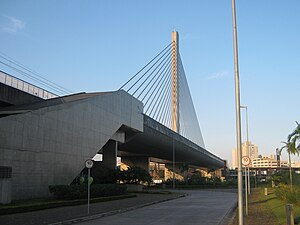Santo Amaro (CPTM)
Santo Amaro | ||||||||||||||||||||||||||||||||||||||||||||||||||||||||||||||||||||||||||||||||||||
|---|---|---|---|---|---|---|---|---|---|---|---|---|---|---|---|---|---|---|---|---|---|---|---|---|---|---|---|---|---|---|---|---|---|---|---|---|---|---|---|---|---|---|---|---|---|---|---|---|---|---|---|---|---|---|---|---|---|---|---|---|---|---|---|---|---|---|---|---|---|---|---|---|---|---|---|---|---|---|---|---|---|---|---|---|
 Santo Amaro Station | ||||||||||||||||||||||||||||||||||||||||||||||||||||||||||||||||||||||||||||||||||||
| General information | ||||||||||||||||||||||||||||||||||||||||||||||||||||||||||||||||||||||||||||||||||||
| Location | Av. das Nações Unidas, s/n | |||||||||||||||||||||||||||||||||||||||||||||||||||||||||||||||||||||||||||||||||||
| Coordinates | 23°39′20″S 46°43′14″W / 23.655693°S 46.720428°W | |||||||||||||||||||||||||||||||||||||||||||||||||||||||||||||||||||||||||||||||||||
| Owned by | ||||||||||||||||||||||||||||||||||||||||||||||||||||||||||||||||||||||||||||||||||||
| Operated by | ||||||||||||||||||||||||||||||||||||||||||||||||||||||||||||||||||||||||||||||||||||
| Platforms | Island platform | |||||||||||||||||||||||||||||||||||||||||||||||||||||||||||||||||||||||||||||||||||
| Connections | ||||||||||||||||||||||||||||||||||||||||||||||||||||||||||||||||||||||||||||||||||||
| Construction | ||||||||||||||||||||||||||||||||||||||||||||||||||||||||||||||||||||||||||||||||||||
| Structure type | At-grade | |||||||||||||||||||||||||||||||||||||||||||||||||||||||||||||||||||||||||||||||||||
| Accessible | Yes | |||||||||||||||||||||||||||||||||||||||||||||||||||||||||||||||||||||||||||||||||||
| Architect | João Walter Toscano | |||||||||||||||||||||||||||||||||||||||||||||||||||||||||||||||||||||||||||||||||||
| Other information | ||||||||||||||||||||||||||||||||||||||||||||||||||||||||||||||||||||||||||||||||||||
| Station code | SAM | |||||||||||||||||||||||||||||||||||||||||||||||||||||||||||||||||||||||||||||||||||
| History | ||||||||||||||||||||||||||||||||||||||||||||||||||||||||||||||||||||||||||||||||||||
| Opened | January 26, 1986 | |||||||||||||||||||||||||||||||||||||||||||||||||||||||||||||||||||||||||||||||||||
| Previous names | Largo Treze | |||||||||||||||||||||||||||||||||||||||||||||||||||||||||||||||||||||||||||||||||||
| Services | ||||||||||||||||||||||||||||||||||||||||||||||||||||||||||||||||||||||||||||||||||||
| ||||||||||||||||||||||||||||||||||||||||||||||||||||||||||||||||||||||||||||||||||||
| ||||||||||||||||||||||||||||||||||||||||||||||||||||||||||||||||||||||||||||||||||||
| ||||||||||||||||||||||||||||||||||||||||||||||||||||||||||||||||||||||||||||||||||||
Santo Amaro is a train station on ViaMobilidade Line 9-Emerald in the Santo Amaro district of São Paulo, Brazil.
Characteristics
[edit]Santo Amaro station, which initial name was Largo Treze, was opened on January 26, 1986 by FEPASA. Currently, it's part of CPTM Line 9-Emerald.
The architectonical project was chosen to be integrated into the collection of the Modern Art Museum of Centre Georges Pompidou in Paris, France. Designed by João Walter Toscano, one of the pioneers of the use of steel in civil construction in Brazil, the station was opened in 1986 and stands out for the transparency and the use of natural light, in a reinterpretation of traditional elements of the railway, like the clock tower that refers to 19th century stations.[1]
In that time, the line currently known as CPTM Line 9-Emerald, of which the station is part of, had Pinheiros station as terminus, and the opening of Largo Treze station was considered by Veja São Paulo magazine "a giant step in the enhancement of this line and the daily transportation of a part of the city population".[2] The same publishing classified the station architecture, of steel and reinforced concrete, as "pretty and dashing".[2] The location of the station is at 2 kilometers south from the old Santo Amaro station, demolished in the second half of the 1970s.
References
[edit]- ^ Mennucci Giesbrecht, Ralph. "Estação Santo Amaro" (in Portuguese). Estações Ferroviárias do Brasil. Retrieved 29 May 2019.
- ^ a b "Trem no Largo 13". Veja São Paulo. Editora Abril. 5 February 1986. p. 14.
External links
[edit]
| ||
| ||
| ||
Text is available under the CC BY-SA 4.0 license; additional terms may apply.
Images, videos and audio are available under their respective licenses.
